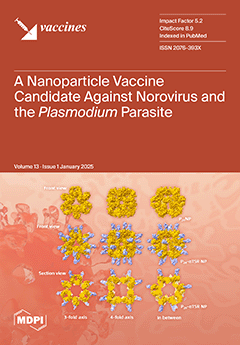Open AccessArticle
Comparing Antibody Responses to Homologous vs. Heterologous COVID-19 Vaccination: A Cross-Sectional Analysis in an Urban Bangladeshi Population
by
Kazi Istiaque Sanin, Mansura Khanam, Azizur Rahman Sharaque, Mahbub Elahi, Bharati Rani Roy, Md. Khaledul Hasan, Goutam Kumar Dutta, Abir Dutta, Md. Nazmul Islam, Md. Safiqul Islam, Md. Nasir Ahmed Khan, Mustufa Mahmud, Nuzhat Nadia, Fablina Noushin, Anjan Kumar Roy, Protim Sarker and Fahmida Tofail
Viewed by 635
Abstract
Background: Vaccination has played a crucial role in mitigating the spread of COVID-19 and reducing its severe outcomes. While over 90% of Bangladesh’s population has received at least one COVID-19 vaccine dose, the comparative effectiveness of homologous versus heterologous booster strategies, along with
[...] Read more.
Background: Vaccination has played a crucial role in mitigating the spread of COVID-19 and reducing its severe outcomes. While over 90% of Bangladesh’s population has received at least one COVID-19 vaccine dose, the comparative effectiveness of homologous versus heterologous booster strategies, along with the complex interplay of factors within the population, remains understudied. This study aimed to compare antibody responses between these booster approaches. Methods: This cross-sectional study enrolled 723 adults in urban Dhaka who had received COVID-19 booster doses within the last six months. Participants were grouped based on homologous or heterologous booster vaccination. Data were collected through structured household surveys, and 2 mL blood samples were collected for measuring antibody titers. Results: Heterologous booster recipients showed higher median antibody titers (8597.0 U/mL, IQR 5053.0–15,482.3) compared to homologous recipients (6958.0 U/mL, IQR 3974.0–12,728.5). In the adjusted analysis, the type of booster dose had no significant impact on antibody levels. However, the duration since the last booster dose was significantly associated with antibody levels, where each additional month since receiving the booster corresponded to approximately a 15–16% reduction in antibody levels (Adj. coeff: 0.85, 95% CI: 0.81, 0.88;
p < 0.001). Participants over 40 years demonstrated higher antibody levels than younger individuals (Adj. coeff: 1.23, 95% CI: 1.07, 1.43;
p = 0.005). Sex, BMI, and prior COVID-19 infection showed no significant associations with antibody levels after adjustment. Conclusion: The results underscore the complexity of immune responses across different demographic groups and suggest potential benefits of ongoing heterologous booster strategies in sustaining immunity.
Full article
►▼
Show Figures






